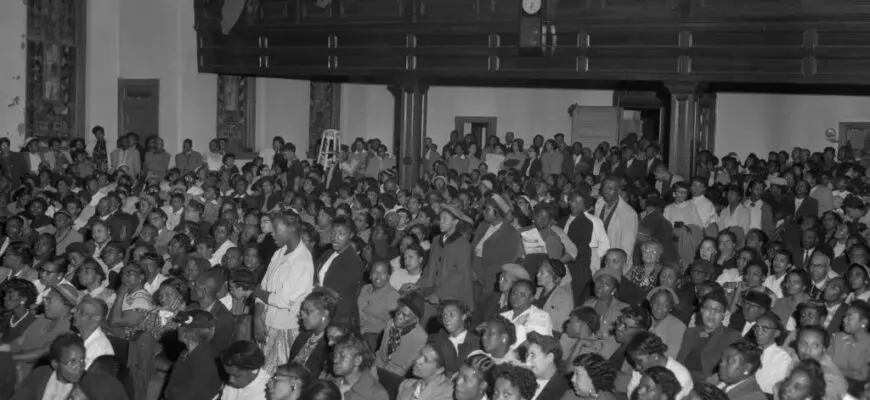While modern activists deploy various tactics to fight political policies, the history of the civil rights movement suggests that success can be found in an unexpected arena: the kitchen. Cook and activist Georgia Gilmore proved this during the Montgomery Bus Boycott, demonstrating that food could be a powerful tool for social change.
In 1955, after Dr. Martin Luther King Jr. and the Montgomery Improvement Association (MIA) launched the Montgomery Bus Boycott, civil rights activist Georgia Gilmore (1920-1990) turned her simple home kitchen on Dericote Street into a battle post. Already an active member of the local National Association for the Advancement of Colored People (NAACP) chapter and known for cooking and selling food to raise church funds, the boycott presented Gilmore with a chance to amplify her talents.
For 381 days, her weapons—fried chicken, sweet potato pies, pound cakes, fried fish, stewed collard greens, and stuffed pork chops—were seemingly simple soul food delicacies. But in the hands of Gilmore and a covert network of Black women cooks she called the “Club from Nowhere,” these foods reconfigured the landscape of public transportation in America, opening up a pathway for all Americans to ride buses.
Gilmore was born in 1920 in Montgomery County, Alabama. She grew up raising hogs and slaughtering chickens, receiving culinary training in southern cuisine from her mother and other women in the community, whose kitchens served as essential classrooms. By the 1950s, cooking offered Gilmore one of the few professional opportunities available to Black women in the South, and she became the top cook at the popular, whites-only National Lunch Company in downtown Montgomery.
Everything changed for Gilmore in December 1955 when police arrested seamstress Rosa Parks, sparking the formation of the MIA and its boycott. Parks’ arrest deeply resonated with Gilmore because she had experienced similar abuse. Three months earlier, a white bus driver had verbally harassed her, called her a racial slur, taken her fare, and forced her to enter the back of the bus—only to then speed off before she could get on. From that moment on, Gilmore had already boycotted the city’s buses, but Parks’ arrest compelled her to do more.
Inspired by King’s call for Black people to use their skills to support the boycott, Gilmore did what she knew best: cook. She organized other Black women cooks, enlisting them to join the Club from Nowhere to sell plates and help fund the protest. She coordinated the delivery of plates to MIA meetings, beauty shops, doctors’ offices, and even cab stands, dispatching her team to secure purchases in support of what would become the longest protest in the history of the civil rights movement.
Stationed in her kitchen, Gilmore practiced what the author calls emancipatory food power—a means for Black people to weaponize food during social unrest as a way to protect themselves from oppression. With each pot and cast iron skillet, Gilmore exemplified this longstanding tradition, resisting the ills of racial segregation that pervaded nearly every aspect of her community.
Gilmore decided to fight racism in the place where she felt most comfortable and where she felt she could make the most difference as a Black woman in America—her kitchen. The room became her command center, empowering Gilmore to carve out her own space to think, organize, and act. While others engaged in high-risk activism like marching and protesting that could cost them their jobs, Gilmore’s kitchen activism involved less risk, yet still changed the course of the civil rights movement.
As national headlines celebrated Parks’ courage and King’s charismatic leadership, Gilmore continued to cook in quiet obscurity. That changed in March 1956 when she testified in court in support of King, who was facing charges for unlawful conspiracy related to the boycott. Gilmore’s testimony shifted the tone of the court hearing, placing a target on her back.
Vividly describing her encounter with the bus driver in October 1955, Gilmore called city bus drivers the “meanest, nastiest” people in the world. She concluded:
“I decided then and there not to ever ride a bus again.”
The next day, a photo of Gilmore between King’s attorneys appeared in the Pittsburgh Courier. Entering the public eye cost Gilmore her job; the National Lunch Company terminated her employment—a common practice used by the white power structure in the South to punish civil rights activists.
Within a few days, however, she received financial backing from the King family to update her kitchen equipment and turn her dining room into a restaurant. From that point on, her in-home restaurant functioned as a “situation room” for the boycott and beyond. Top secret conversations about movement strategies and tactics abounded over plates of Gilmore’s food.
The boycott finally ended on December 20, 1956, after the U.S. Supreme Court ruled that segregation on public buses was unconstitutional. With the victory, Gilmore disbanded the Club from Nowhere. However, her activism continued; her in-home restaurant took on a new life, serving as a meeting place for the movement as struggles for voting rights took center stage. It became a cornerstone in the system of Black eateries in the South that served as safe havens for activists, including Peaches in Jackson, Mississippi, Dooky Chase’s in New Orleans, and Paschal’s in Atlanta.

King was a regular visitor, and even after he left Montgomery for Atlanta, he returned to Gilmore’s restaurant in 1965 to eat as he prepared to make his way to the Edmund Pettus Bridge to participate in the Selma March that catalyzed the Voting Rights Act.
Over the next decade, Gilmore’s list of patrons included prominent American figures such as President Lyndon B. Johnson and Senator Robert F. Kennedy. Dignitaries crossing the threshold of Gilmore’s home to eat and discuss the future of the nation’s democracy illustrated why she believed that food could be a tool in helping to redirect America’s trajectory toward an equitable future for all.
Though she never attained fame, without Gilmore’s strategic thinking and sharp culinary skills, the Montgomery Bus Boycott may not have succeeded. The legacy of her kitchen activism offers a way forward for Americans fighting against modern political policies. While some will march or protest, those less comfortable with those forms of advocacy can follow in the footsteps of Gilmore—as the Ghetto Gastro, a Black-led Bronx-based chef collective that is fighting systemic racism through emancipatory food power rooted in community, is doing. In embracing food as a tool to fight injustice, activists would be amplifying a tradition that was at the heart of Gilmore’s kitchen.








